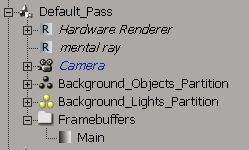Render passes are a mechanism for dividing a scene into several "layers", each of which isolates different scene attributes, such as shadows, lighting components, ambient occlusion, mattes, and so on.
Render channels are a mechanism for outputting multiple images, each containing different information, from a single pass. When you render the pass, you can specify which channels should be output in addition to the full pass. By default, a Main render channel is declared for every pass (you can think of it as the "beauty" channel rendered for each pass).

Preset render channels allow you to isolate scene attributes that are commonly rendered in separate passes. All you need is your default pass and you can quickly output the preset ambient, diffuse, specular, reflection, refraction, and irradiance render channels.
For more information about taking full advantage of render channels, see Render Channels & Framebuffers.
Rendering a scene in passes can be extremely useful for isolating specific elements of a scene in order to have more flexibility when creating special effects in post production. Although similar in concept, there is a big difference between passes and scene layers.
Scene layers are used to separate elements of a scene so they can be visually organized or hidden to optimize interaction. Layers mainly affect the 3D views and the render region.
Passes and their partitions separate scene elements for rendering so they can be individually tweaked or edited.
The Pass  Edit
Edit  New Pass
New Pass  Based on Layers command on the Render toolbar creates a new pass pre-populated with partitions based on the existing scene layers.
Based on Layers command on the Render toolbar creates a new pass pre-populated with partitions based on the existing scene layers.
For more information on scene layers and how they are used, see Scene Layers [Scene Elements].